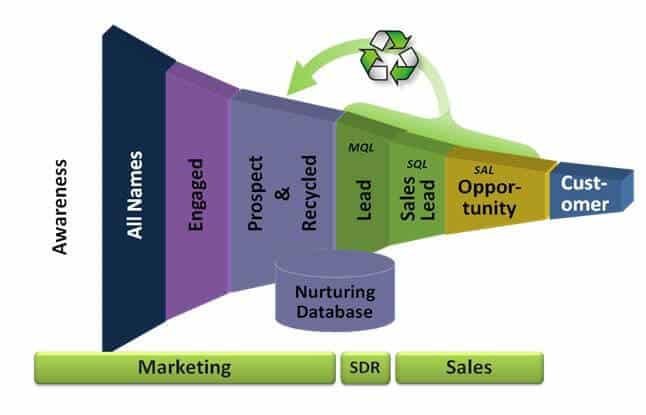Achieving Marketing & Sales Alignment using Marketo and Salesforce.com
Marketing and Sales are a part of the same funnel that captures revenue for the business. Marketing communicates with segments of prospects, who demonstrate buying potential through their traits and actions. Sales communicates on a one-on-one level with a prospect once the latter demonstrates clear interest. Marketing and Sales have the same objective of closing business, but being closer to the bottom of the funnel, Sales is more easily able to attribute sales efforts to dollars closed. What is a mighty feat, however, is attributing marketing influence to Closed Won business. Even though Marketing automation platforms like Marketo, Eloqua, Hubspot enable the automated tracking and recording of email campaigns, communications with targeted segments, or webinars and tradeshow attendants, ultimately, Marketing is beholden to Sales to maintain the data that connects closed business to marketing initiatives. Thankfully, Marketing has significant leverage as they may threaten to inundate Sales with dead Leads!
I want to highlight some common attributes that Sales controls, which may impact the most basic Marketing reporting when working with Salesforce.com and Marketo:
1. Lead Process between Marketo and Salesforce.com
Lead Scoring Model: Sales should have a good understanding of how Marketing has constructed their scoring model based on demographic and behavioral traits of an unknown individual. Determining the criteria at not only when Marketo syncs Leads over to Salesforce.com, but also when Leads are assigned to a Sales Rep based on Lead Score, and revising this periodically, can enable better conversion rates by reducing the gap between the number of Marketing Qualified Leads and the number of Sales Accepted Leads. Additionally, insight from Sales regarding optimal buyer characteristics can inform the scoring model significantly.
Lead Lifecycle: The Lead Lifecycle starts in Marketo (Anonymous, Contacted, MQL etc), goes through the Sales stages and then is often recycled back into Marketo. Therefore, both teams are generally in control of a different segment of the process. It is important that teams communicate while setting up stages that will define the Lead Lifecycle, identify the stages at which a handover occurs between teams, and agree on the criteria that define these stages.
Lead Partition and Assignment: Once leads sync over to the CRM, there there are benefits to assigning the Leads to an individual or a team. The Lead Owner is expected to work this Lead, and be held accountable if there is no further follow up by Sales. Lead Assignment Rules in Salesforce can be used to automate this process, but the two teams would have to put their heads together to come up with criteria for Lead Assignment. While the Sales VP will have ideas on which team/individual is the best person for a particular categorization of incoming Leads, the VP of Marketing, having an understanding of the prospect segments, can shed light on criteria that might help create more balanced Lead Assignment groupings.
2. Missing Contact Roles
Contact Roles are the link between Marketo Programs and Closed Won dollars, and enables Reports generated in both Marketo and Salesforce.com to display metrics and visuals of the interaction: when a Lead is created in Marketo, the nurture track, and then the association with an Opportunity in Salesforce.com. When Marketo Campaign Sync is set up, and the Opportunity in Salesforce.com is created via Lead conversion, then the resulting Contact is automatically associated with the Opportunity. However if, let’s say, Macy Daniels has interacted with marketing separately, and then called the sales team directly, then an Opportunity might be created either association of Contact Roles, or attribution to marketing efforts. If your company’s lead generation sounds like this, we can often write a custom Apex Trigger to require a populated Contact Role prior to moving an Opportunity to Closed Won.
3. Correct Amount on Closed Won Opportunities
This might be the most difficult piece, as it is not simply about requiring Sales Reps to enter the data, but enforcing some kind of mechanism to check that the amount is accurate. Unless quotas for closing business are reported out of Salesforce.com, there may be very little reason for a Rep to enter all of the data. Additionally, if your Reps can be shown benefits via productivity gain, the value of individual pipeline management, and easy lead follow up, these are often strong incentives to maintain accurate data in the system.
Sounds like a big project to reassess whether your marketing automation platform and CRM is properly synced, or if your marketing and sales processes are aligned? A periodic Marketing Operations Assessment may be the key to increasing conversion rates, and properly attributing Closed Won business with your marketing efforts.
